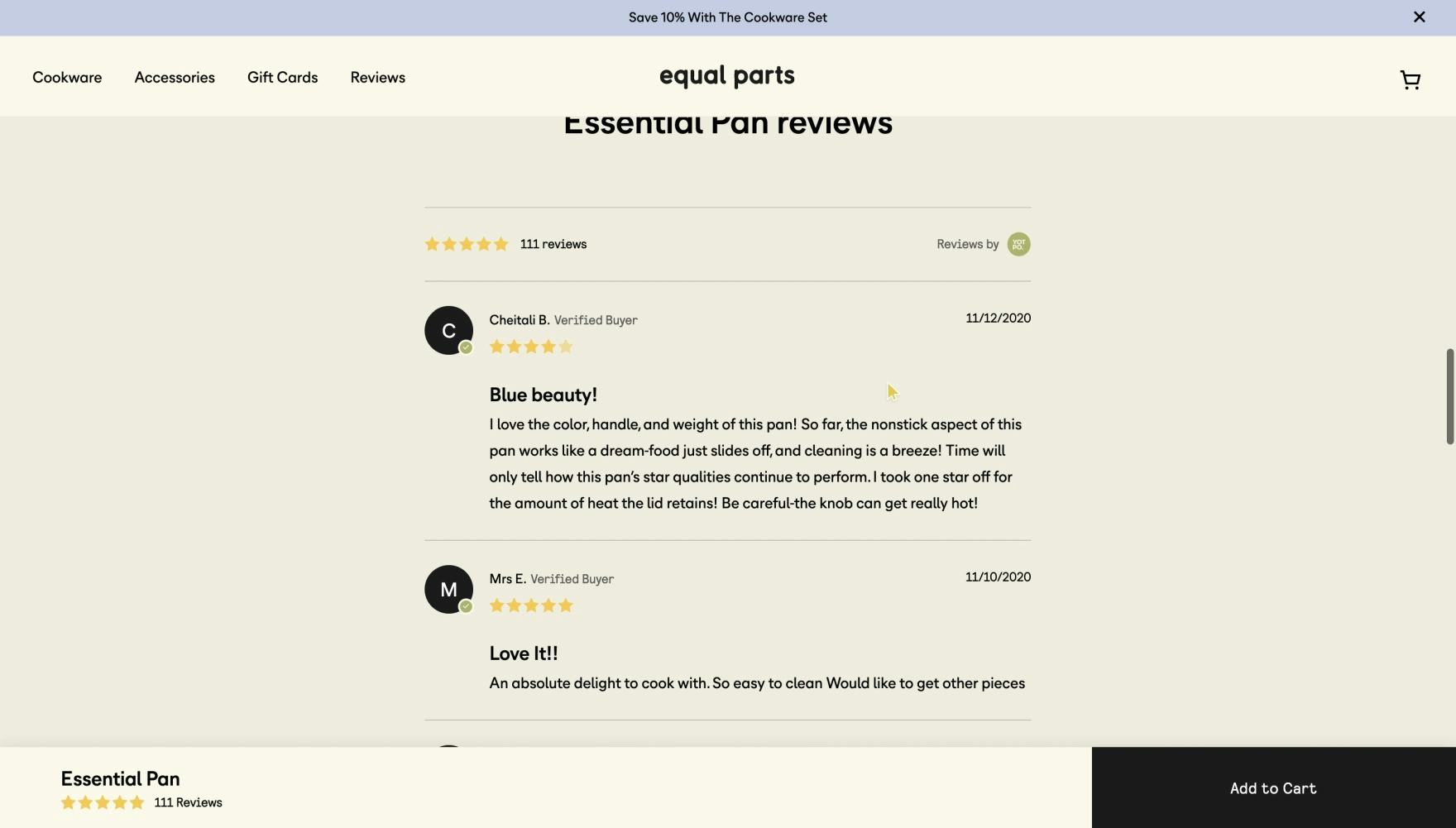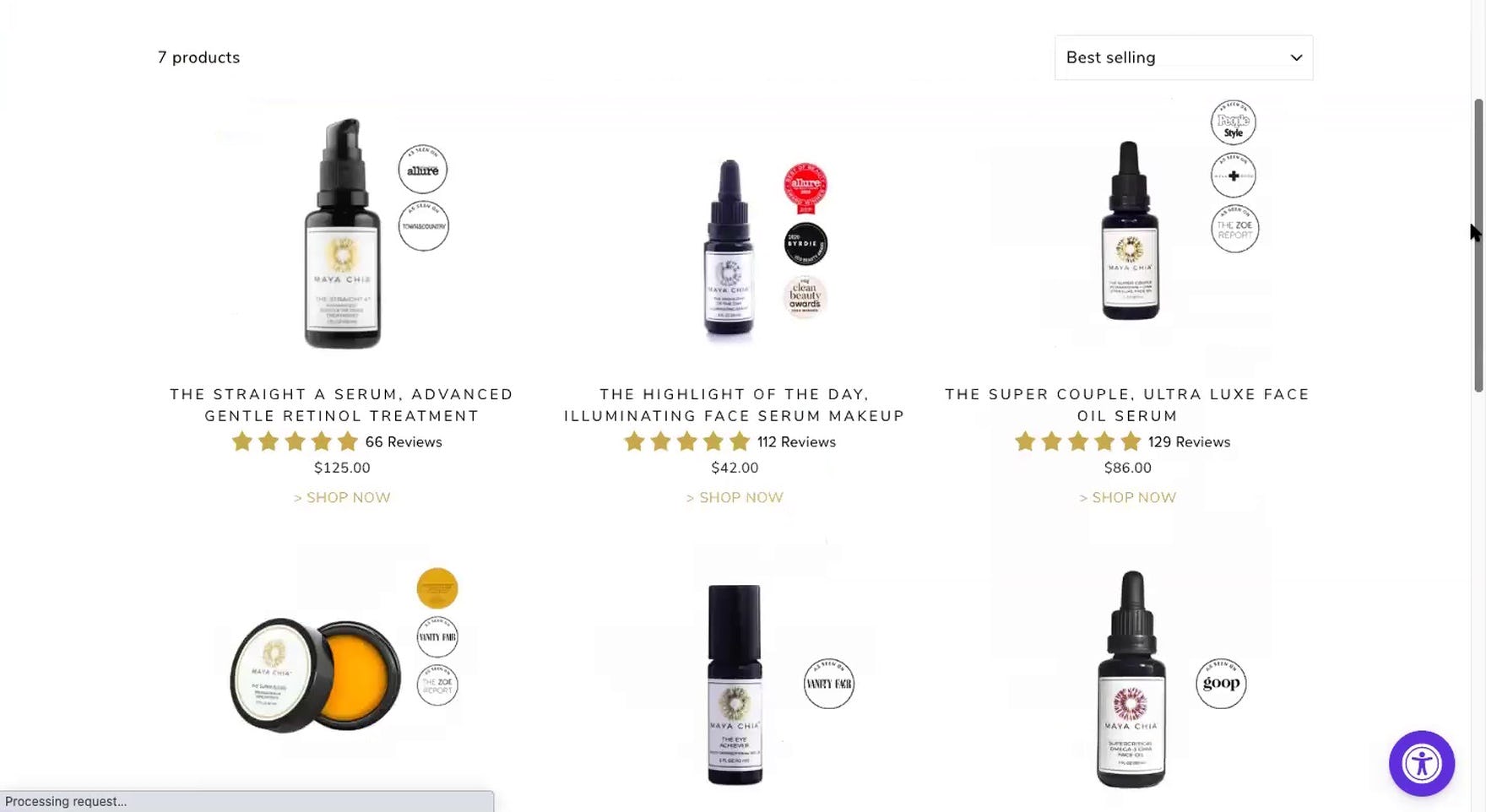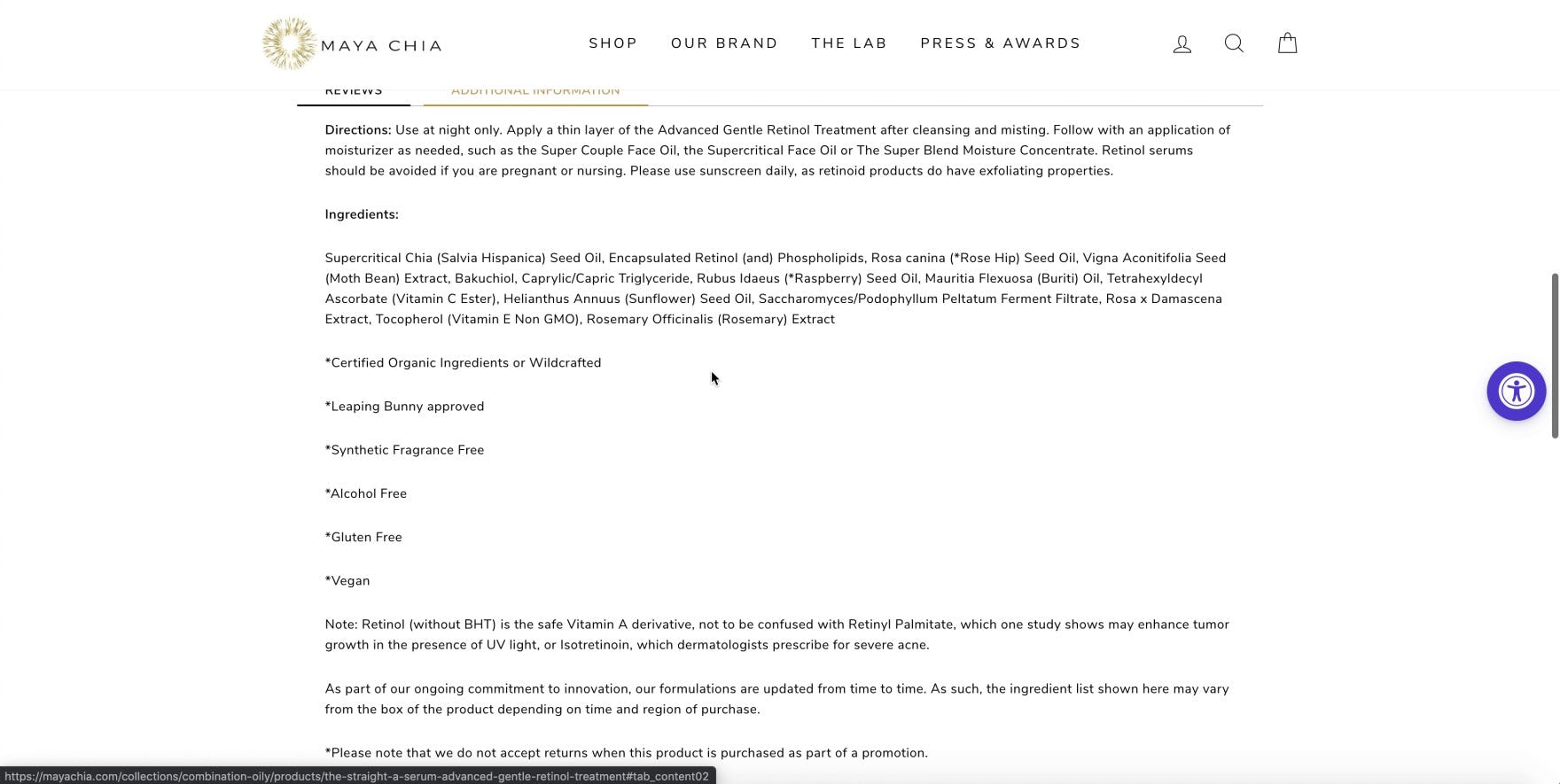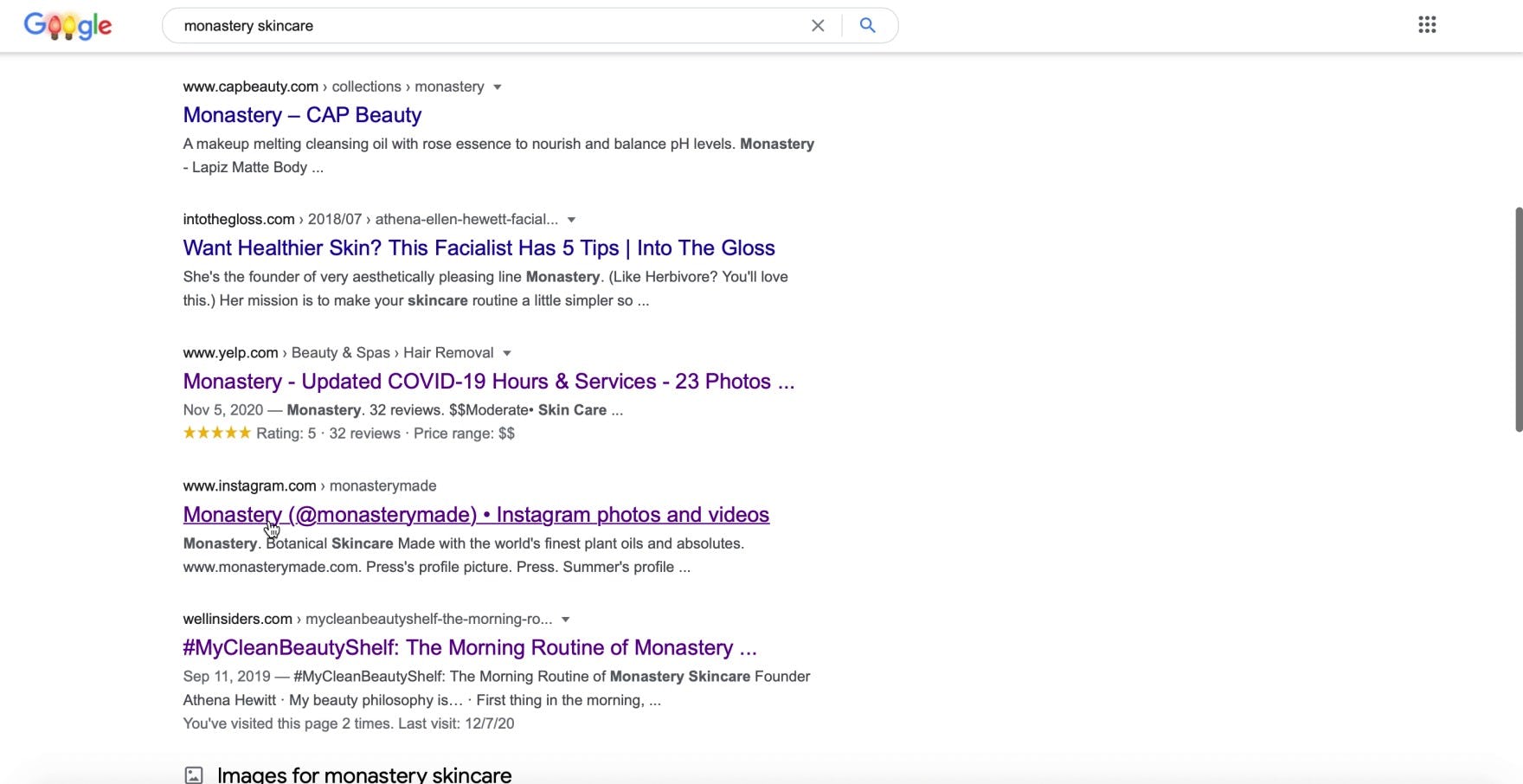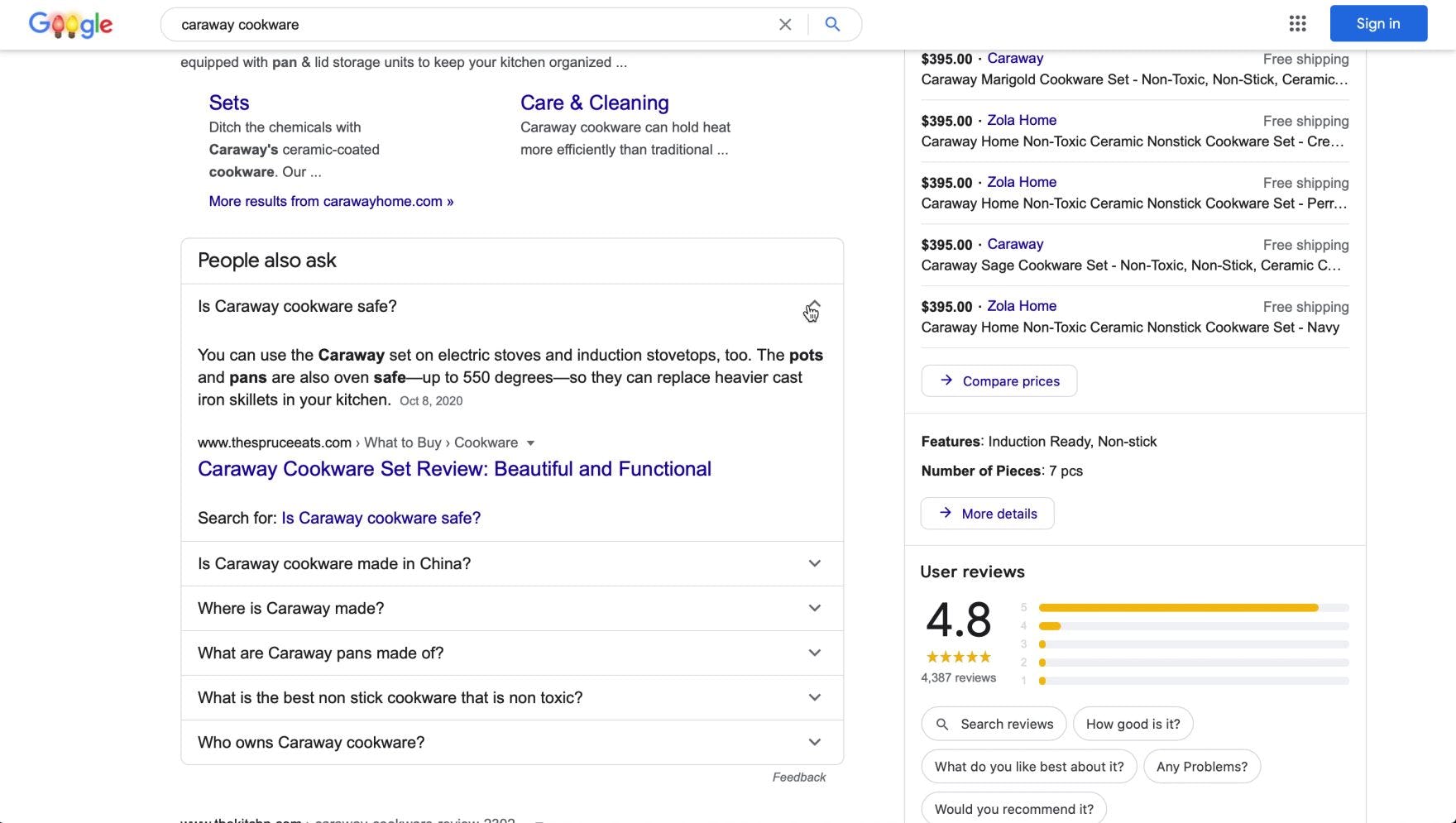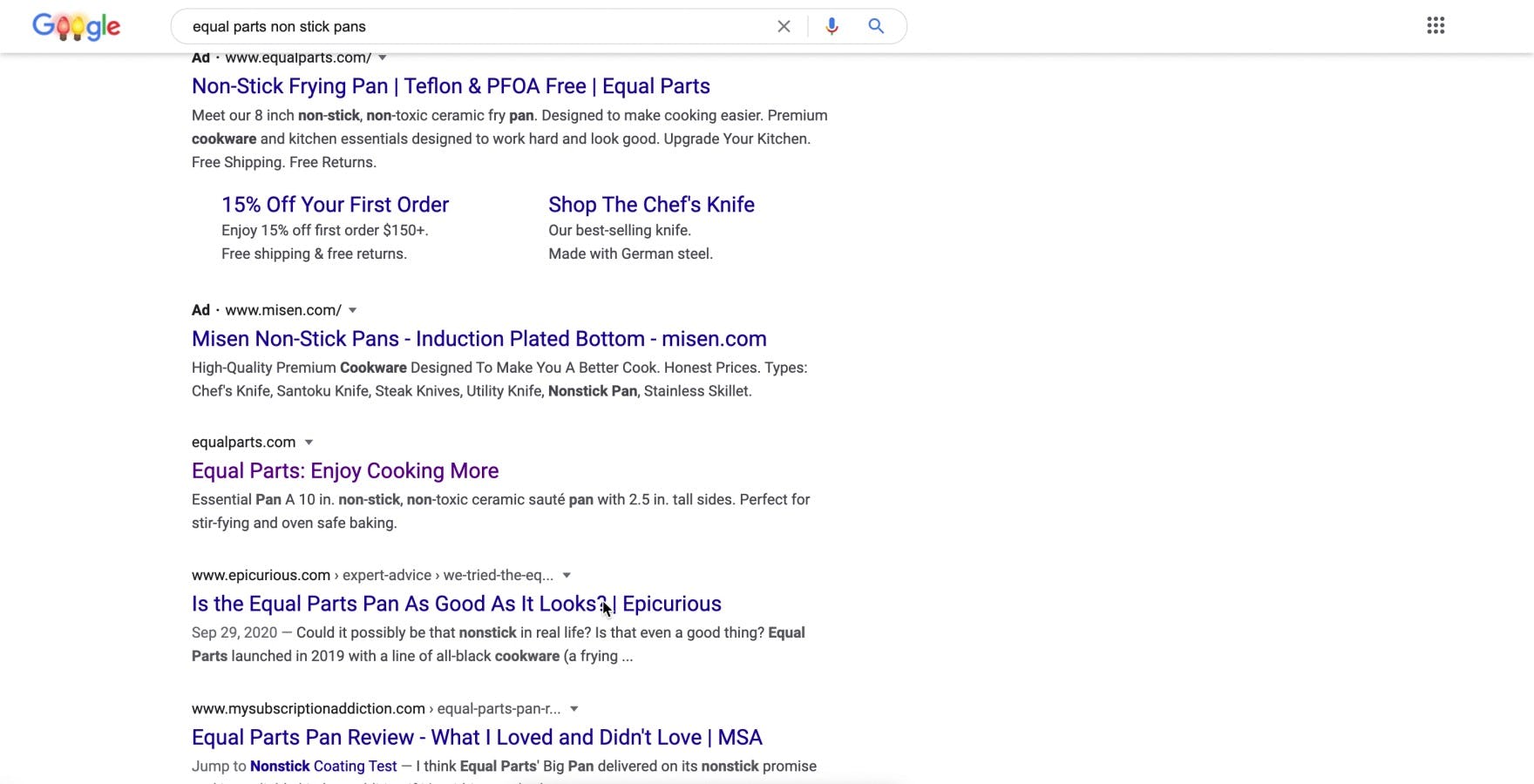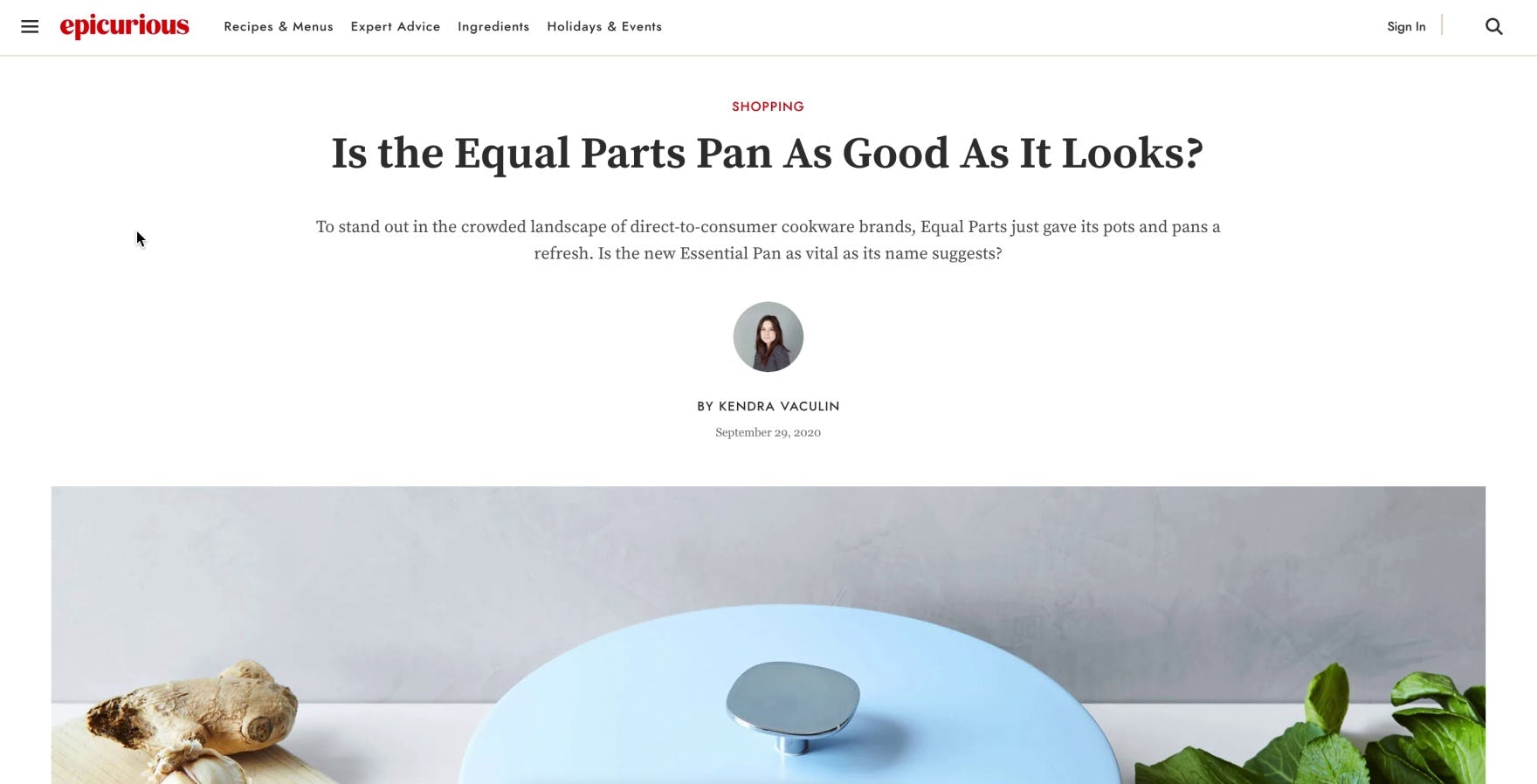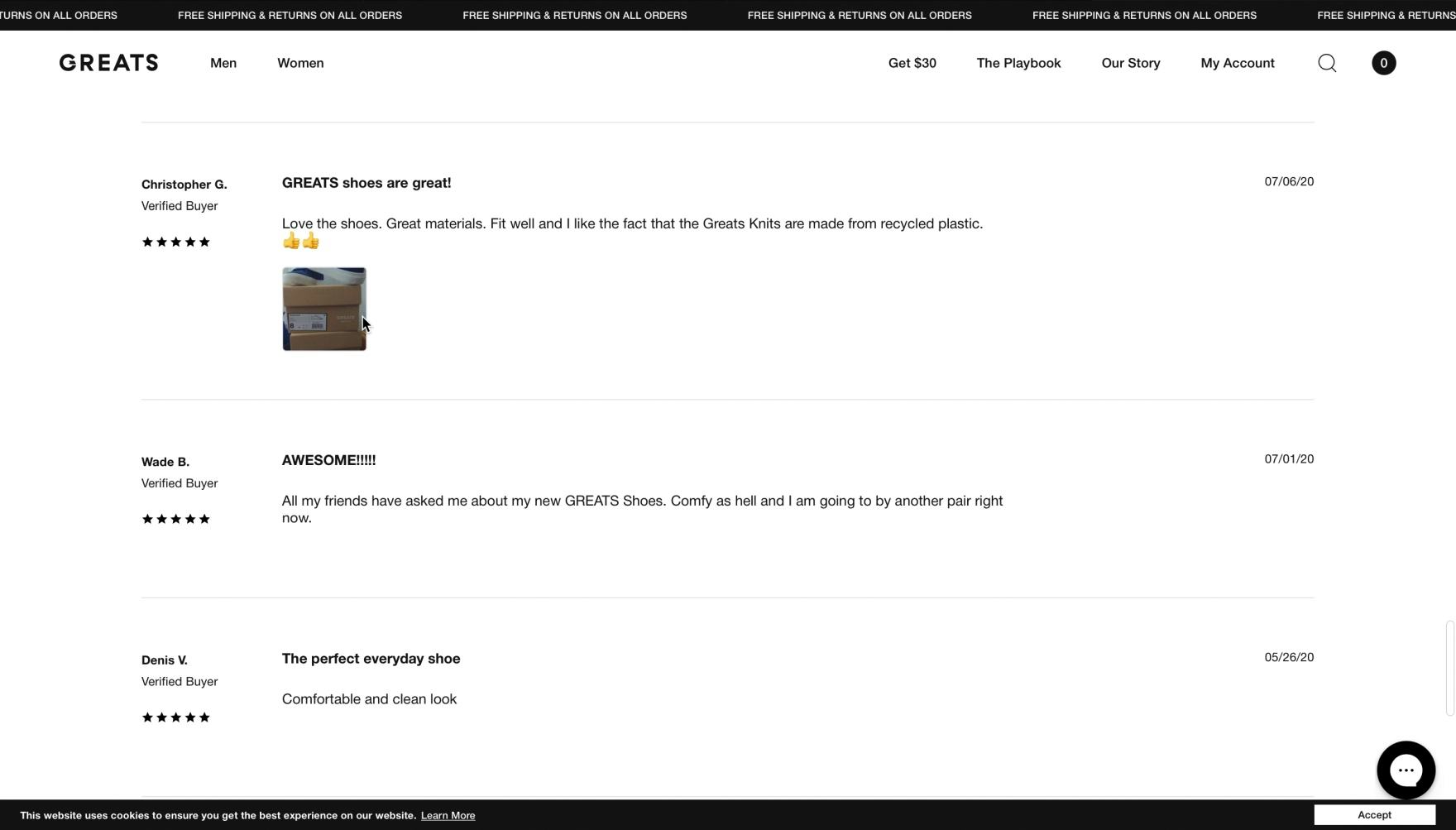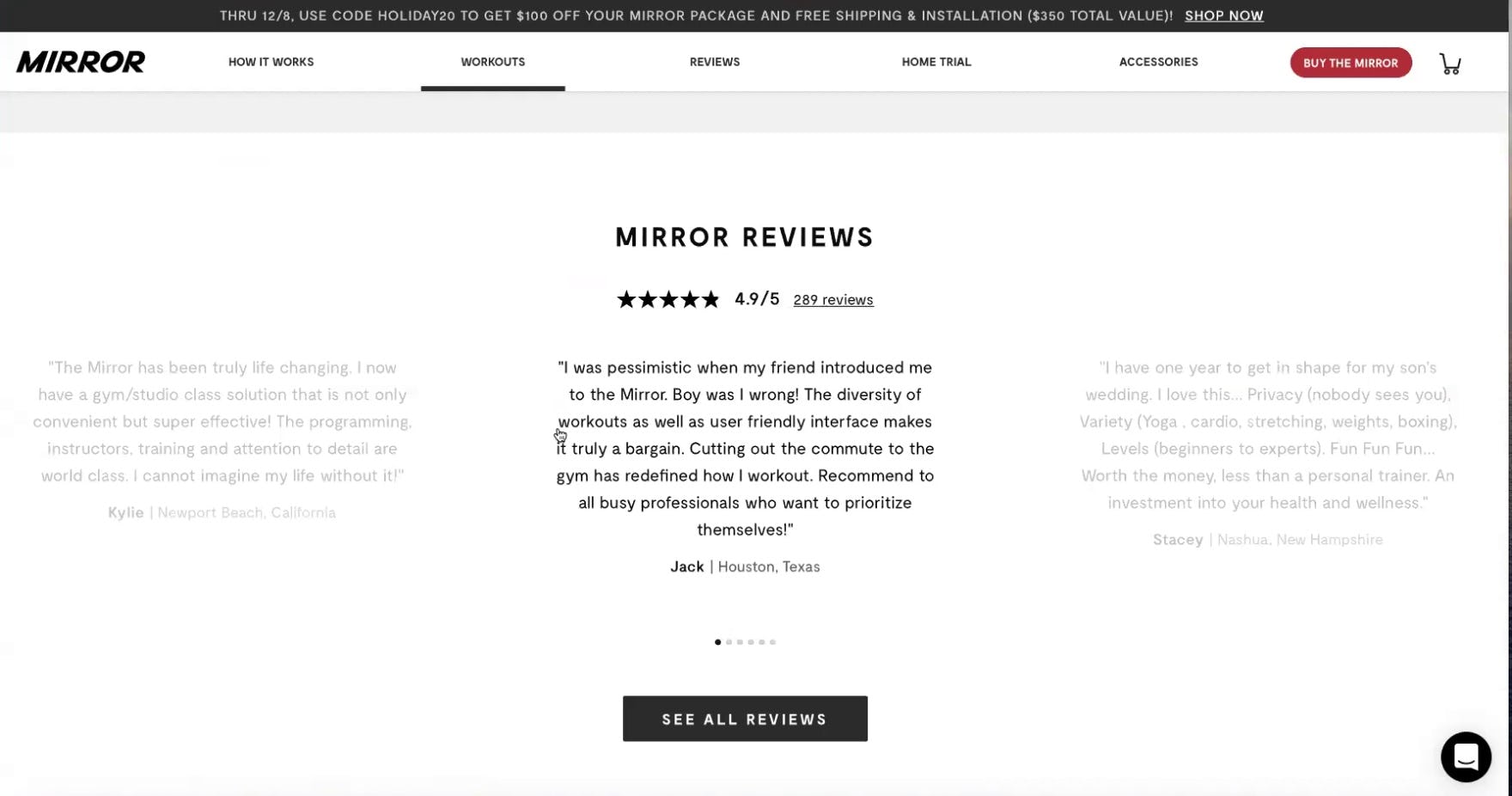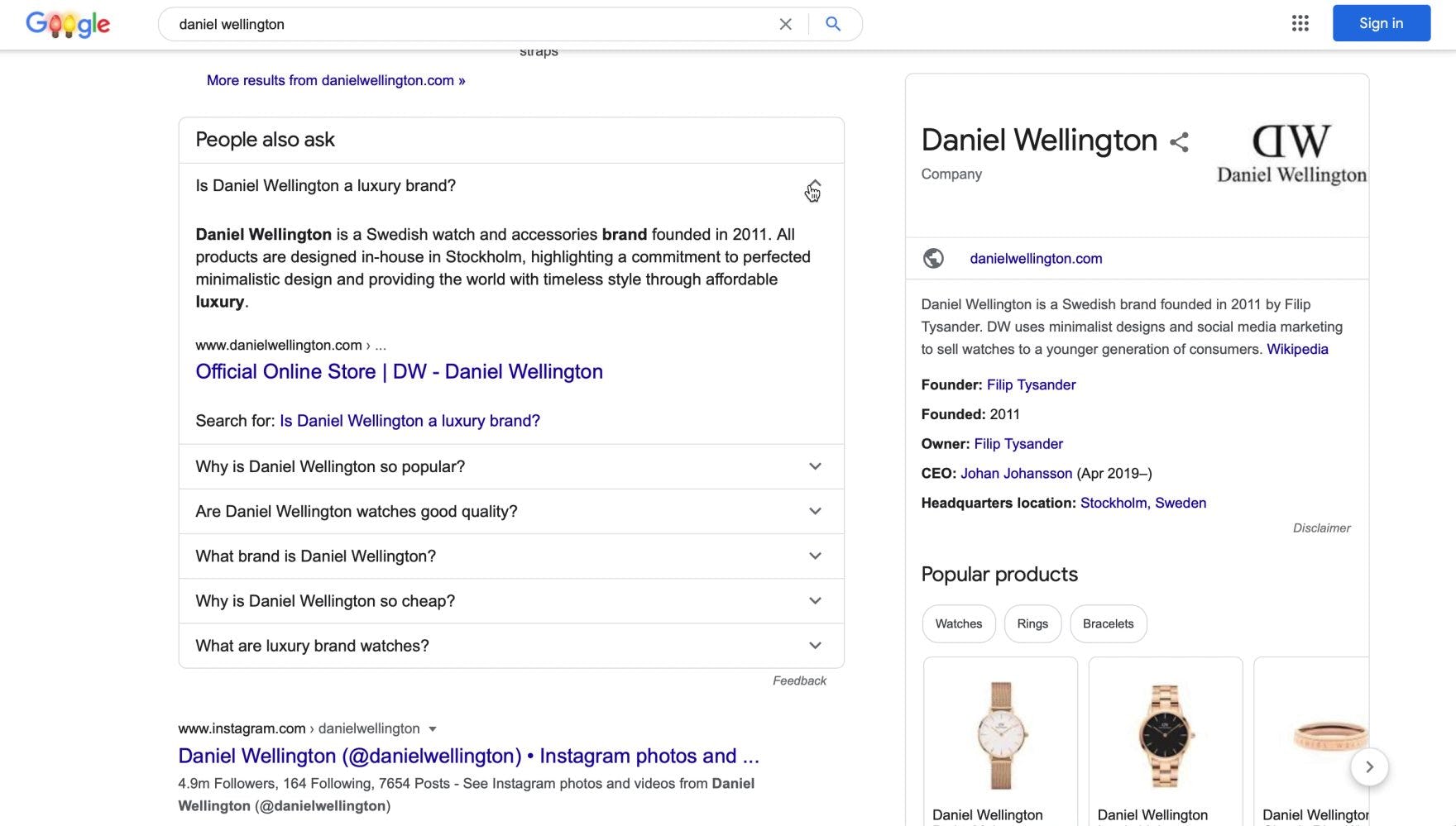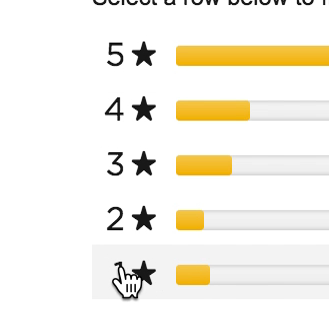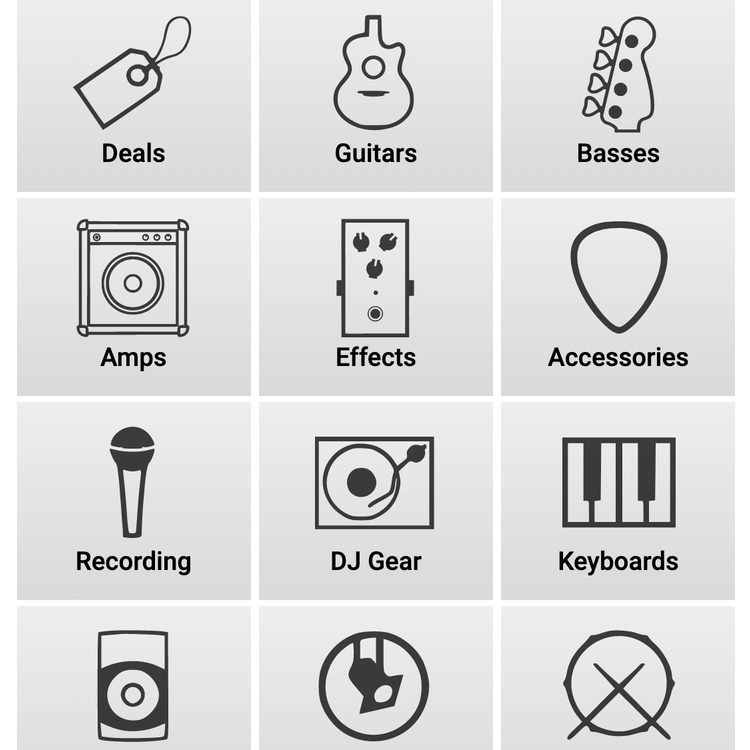Key Takeaways
- Our large-scale testing of DTC e-commerce sites reveal that users are extremely skeptical of reviews on direct-to-consumer sites — far more than on standard e-commerce sites.
- When reviews are available, DTC users spend very little time considering them compared to reviews on larger, more traditional sites.
- Regardless of whether reviews are available, users nearly always want to seek external reviews before feeling confident with purchasing, prioritizing third-party content over that available through the retailer.
On standard e-commerce and mass merchant sites like Amazon, Walmart, and Home Depot, reviews are one of the most heavily utilized parts of the site. In fact, in our large-scale UX testing of traditional e-commerce sites, reveal that upwards of 95% of users rely on site-provided user reviews to evaluate products.
However, in our large-scale UX testing of direct-to-consumer DTC sites, we observed that, far from being one of the most essential tools for learning about products, users typically only glanced through site-provided reviews, relying far more heavily on other product page information and — importantly — off-site review content for making their purchase decision.
In this article we’ll discuss some of the key test findings from our research on on site-provided user reviews, including:
- Why DTC users are so skeptical of site-provided user reviews
- What kind of resources DTC users rely on instead of site-provided reviews
- How to help overcome users’ skepticism and better support their product exploration
Why DTC Users Are So Skeptical of User Reviews
“I just saw that there’s also reviews…but I usually wouldn’t trust reviews on such a website because it can obviously be easily rigged, so they would probably not show any negative reviews. I would only trust reviews on Amazon.” A user on Allbirds expressed her difference in trust between DTC/manufacturer sites and larger retailers (who are primarily resellers of other brands). In practice, users are more trusting of reviews on reseller sites than the brand’s own.
Although review authenticity is a common concern for users of any site, users during testing of DTC sites were so skeptical of reviews being manipulated or faked that it almost completely undermined their use of reviews as a key source of product information.
While the majority of users noted when reviews were available, only a very small subset gave them more than a passing glance, citing a preference for third-party reviews through Google, social media, or “expert” sources like Consumer Reports.
Users during testing of DTC sites were quick to point out that brands will always seek to present their products in the best possible light, making any claims or review information inherently biased.
For instance, one user in testing remarked, “I don’t usually take [reviews] very seriously on a manufacturer website because…they’re probably not, but they very easily could be altered or ordered in a certain way to make me think more favorably of the product…I very rarely spend any time on reviews on manufacturer sites usually, just because I know they usually pick the best ones”.
In testing, 62% of DTC users stated that they would engage in their own research and seek third-party or external reviews before being confident enough to purchase products from an unfamiliar brand. What’s more, 29% of users actually went off-site during the test session to find reviews or external information.
“Even though they have reviews linked, I would probably do a quick Google myself and see what else comes up…I’ve become a little bit of a jaded consumer [laughing], and so I always like to do a little bit of extra due diligence.” Like many users during testing of DTC sites, this user on Maya Chia referenced on-site reviews but shared a need to confirm the overall review sentiment through external sources.
Even users who engaged with the reviews on DTC sites typically did so superficially, spending only a minute or so skimming the content. Notably, no users were observed to be swayed by review content as to whether they would purchase a product (or not) — which was not the case when testing on larger conventional sites.
In general, DTC test users expressed that they would still need to perform additional external research to confirm the reviews they had just read before feeling comfortable enough to consider purchasing from the brand. In short, site-provided reviews, in the absence of third-party confirmation, are not enough to sway users’ purchasing decisions on DTC sites.
During testing of DTC sites, users didn’t complain about sites like Monastery that completely neglected to support user reviews, nor were they less likely to purchase from these brands. Users are likely to seek external sources of review information, regardless of whether they are included on the site or not.
Also, notably, during testing no users “penalized” DTC sites that didn’t have reviews. Instead, users may have off-handedly commented that a site was lacking reviews, but continued on with their exploration (rather than abandon the site, which was a commonly observed outcome for products with no reviews when testing traditional e-commerce sites).
What Sources DTC Users Rely on to Learn About Products Besides Site-Provided Reviews
“I’m really impressed with this because it’s really easy to see what ingredients are being used and everything.” This user on Maya Chia appreciated the level of detail included in the product description, a key source of product information for users on DTC sites.
As on traditional ecommerce sites, users during testing of DTC sites relied heavily on site-provided information such detailed product images and rich product descriptions to learn more about products.
However, compared to users traditional retailers, users on DTC sites spent far more time with this kind of site-provided information — and far less time with user reviews, making accurate and high-quality product details commensurately more important for DTC sites.
“I would go here [to Google]…just to see all the stuff that comes up with it.” In addition to browsing Monastery’s site, this user turned to Google to learn more about the brand (first image). She was especially keen to see the brand’s social media presence, opening the search result for Instagram (second image).
To supplement site-provided information and provide independent verification of reviews and overall sentiment, users in our large-scale DTC testing repeatedly turned to external resources, such as general web searches and social media, reasoning that third-party sites would be less prone to bias and manipulation and therefore be more trustworthy.
For many users, third-party sources of information serve a vital role in confirming (or failing to confirm) site-provided content such as product claims and user reviews. In practice, users turn to external sources as a way to verify claims against real user experience, often trusting these sources more than the brand itself.
“Okay, before I buy this, I would go to Google.” This user interrupted her browsing session on Caraway to search for third-party reviews and information about the brand. During testing of DTC sites, many users turned to Google or social media while exploring products, with a majority expressing that they always perform external research before making judgments about a new brand.
During testing of DTC sites, the most commonly mentioned or sought-after external resource was a simple internet search, reflecting users’ desire to cast a wide net and “see what’s out there” in terms of general mentions or reviews of the brand.
In practice, a general web search will turn up third-party reviews and social media profiles, as well as relevant media or news mentions (both positive and negative), making it a good starting point for learning about an unfamiliar brand.
Given users’ extreme distrust for site-provided reviews on DTC sites, finding third-party feedback from external sources serves to verify the accuracy of the brand’s claims and is generally regarded as more trustworthy.
“I usually trust people writing articles on blogs.” This user’s Google search (first image) during testing of Equal Parts turned up blog articles that piqued her interest and increased her trust in the brand (second image). External reviews from perceived experts can carry extra weight for users seeking to learn more about a brand and its products.
Independent sources, including media and news outlets, blogs, and review sites like Consumer Reports, are likely to be perceived as less biased and more authentic, having “less of a stake” in presenting the brand’s products in a positive light. What’s more, feedback from domain-specific sources or experts (e.g., a chef’s or cooking magazine’s review of cookware) is likely to carry additional weight.
“Typically I go straight back to Google…when I’m looking for shopping stuff, I’ll actually just search the brand and see…I would try to find it elsewhere and see what real people are saying…second typically I’ll look on Reddit or something like that, because I often kind of peruse there and see what people have to say.” This user on Daniel Wellington expressed a preference for using Reddit as a source of seemingly unbiased information on watches and other products he might consider.
Among more specific off-site resources, Instagram, Reddit, and Youtube were the most popular among users on DTC sites. Of course, the exact resources or social media platforms used by DTC users to explore different brands and products are likely to vary depending on individual DTC brands’ specific industry, products, and customer demographics.
For many users, the third-party nature of social media posts also allows them to serve as a source of independent review content, being perceived as more authentic.
In effect, social media mentions serve as additional social proof of how successful and effective the brand is; as another user stated on her desire to see a brand’s Instagram,
“I just want to see what they’re doing in terms of the community and see what they’re posting, seeing it set up in people’s houses. That’s really cool.” A user browsing Tempo navigated to the brand’s Instagram account hoping to see real-life examples of the product in use.
Finally, for many users, social media in general provides a unique way to observe how the brand presents itself and interacts with its customers. In particular, users may be interested in how the brand responds to negative feedback or purported issues (similar to viewing site responses to negative reviews.
How to Help Overcome Users’ Skepticism and Support Their Product Exploration
“So there’s reviews, but I probably wouldn’t pay much attention to these reviews. I would probably pull up a different site to look at reviews from a third-party site…I feel like sometimes they might be picked specifically because they’re positive reviews, so I’d look for people’s real-life experiences with the item.”
Given the underwhelming influence of on-site user reviews, paired with the intense desire for external sources of product feedback, DTC sites without user reviews should consider users’ overall skepticism and low usage rate of this content before investing heavily in developing this feature.
That said, while reviews on sites that had them were generally viewed very skeptically, they also generally speaking didn’t hinder users, or deter them from exploring the site’s products.
This user on Equal Parts wanted to see negative reviews — a common desire we’ve observed across many studies — and clicked around the page looking for a way to filter or sort the reviews to no avail. The inability to find critical reviews can lead users to believe that the site is censoring user-generated reviews, further undermining trust in this content.
“Oh, they have photos in the reviews, this is great. Now I can trust reviews a little bit more…If there’s a review that has a photo…this is how it’s probably looking in real-life…this gives me a real picture of what the shoe looks like.” This user on Greats found the images included alongside reviews very compelling, offering a trustworthy indication that these reviews were from real users. Any features that enhance the perception of authenticity will be even more impactful for DTC sites compared to larger retailers.
In practice, DTC sites that choose to offer reviews must go to great lengths to present them as authentic and trustworthy — indeed, offering reviews that may be easily construed as doctored or manipulated can tarnish the brand’s reputation and be worse than not offering reviews at all.
Any reviews features that underscore their authenticity, including the ability to filter for negative reviews and allowing users to attach their own photos, are essential for overcoming users’ overall skepticism of DTC reviews.
As with user reviews on larger sites, users shopping on DTC sites are keen to read negative reviews, and keeping them readily available and easy to find can actually enhance users’ perception of and trust in the site.
“They’ve got reviews…With all this stuff, too, I’m always googling outside of their own websites just to see unbiased reviews, or if there’s…a magazine or website that does reviews of things. I feel like that’s a good way to get more info on it.” This user on Mirror shared how she supplements site information and reviews with third-party sites, hoping to get more independent feedback. External sites, uncovered through online search, can heavily influence users’ opinion of the brand.
With users’ keen focus on third-party information, prioritizing the brand’s off-site reputation through social media, influencer marketing, and search engine optimization is likely to be more impactful than offering on-site reviews.
To this end, monitoring search engine and social media results should be a central part of most DTC brands’ overall strategy. In practice, this may involve investing in search engine optimization and proactive outreach to help ensure the results that come up are positive, informative, and beneficial.
Additionally, curating the brand’s social media presence and participating in social media outreach or influencer marketing may help ensure quality information surfaces when searching for the brand on platforms such as Instagram.
Of course, sites should strive to be transparent and honest in curating any off-site resources. Obviously contributing to sponsored content that seems inauthentic, or censoring negative reviews or press, can deeply tarnish brand perception by lowering perceived trustworthiness. Effectively, all third-party resources on the brand should appear genuine and come with “no strings attached” in order to serve as the independent confirmation users seek.
“Okay, so this is more reassuring.” This user, like many on Tempo, appreciated the featured images on the homepage derived from the brand’s Instagram account. Featuring social media content directly within the site provides a more seemingly authentic representation of the product in use.
“Oh, let’s look at this — ‘Shop Instagram’. I like this section, actually. I like the aesthetic of it, and I like seeing how the watch is paired with other jewelry and outfits.” This user on Daniel Wellington spent time exploring the “Shop Instagram” page featured in the main navigation. Essentially displaying a shoppable replica of the brand’s Instagram feed, this level of integration can provide some of the benefits users seek from social media while keeping them on the site.
Taking social media investment one step further, brands can also consider facilitating exploration of their social media messaging by integrating social media content such as Instagram posts into the site itself.
Such integration can be a natural fit on the homepage, product pages, or as a separate dedicated page (e.g., “Shop Instagram”). At a minimum, sites can link to their social media pages in the global footer, a conventional and commonly sought location for these kinds of links.
Prioritize the Tools and Sources DTC Users Already Rely On
“The site’s only going to say positive things about their products because they’re trying to sell it…I’m not looking for critiques, necessarily, I’m just looking for blunt honesty.” This user shopping on Daniel Wellington turned to Google to find “unbiased” information on the brand’s products. For most users, the inherent skepticism of site-provided reviews on manufacturers’ sites is hard to overcome.
Our DTC usability research study suggests that, for the majority of users, site-provided user reviews will never be more important than external, third-party review content. Small DTC sites should be aware of users’ inherent and strong distrust of reviews on direct-to-consumer sites.
As a worthy alternative to site-provided reviews, brands can consider instead prioritizing investment in their off-site presence and perception, including social media and search engine optimization.
Meanwhile, for sites that choose to offer on-site user reviews, it’s vital to include features to bolster the perception of authenticity, such as star-rating filters and user-generated photos.
Effectively, small DTC brands need to build trust with users by providing review content — whether off or on the site — that is authentic, independent, and unbiased.
Getting access: all 413 DTC UX guidelines are available today via Baymard Premium access. (If you already have an account open the DTC Study.)

